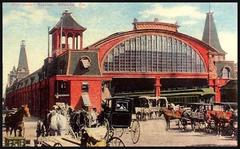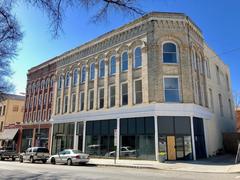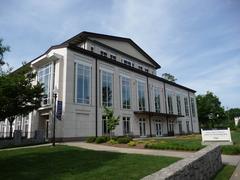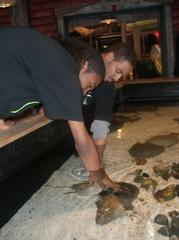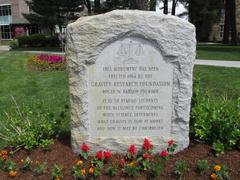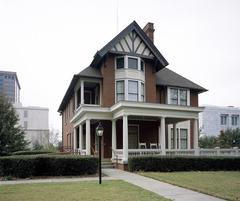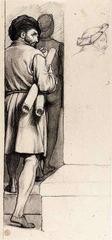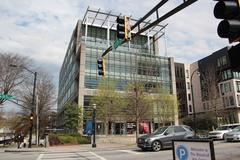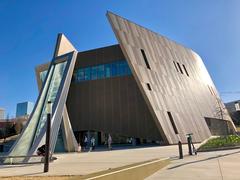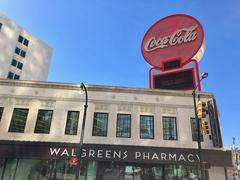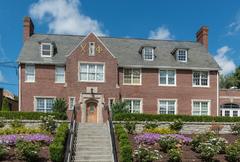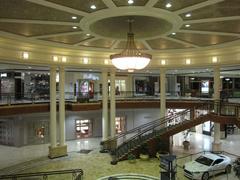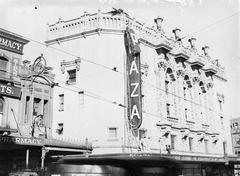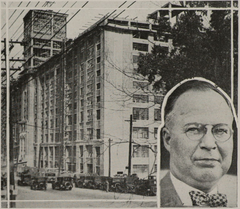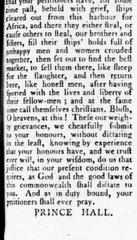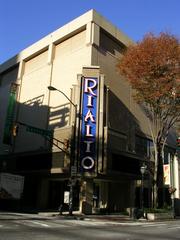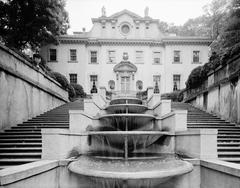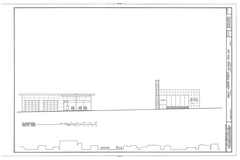
Rufus M. Rose House Visiting Hours, Tickets, and Atlanta Historical Sites Guide
Date: 03/07/2025
Introduction
The Rufus M. Rose House remains one of Atlanta’s most significant architectural and cultural treasures. Located at 537 Peachtree Street in the vibrant SoNo district, this Queen Anne Victorian mansion is a rare survivor of Atlanta’s Gilded Age and a tangible link to the city’s post-Reconstruction growth. Built in 1901 for Dr. Rufus Mathewson Rose—a prominent businessman and founder of the R. M. Rose Company distillery—the house reflects both Atlanta’s entrepreneurial spirit and the elegance of turn-of-the-century design. Today, the Rose House captivates historians, architecture enthusiasts, and visitors eager to connect with Atlanta’s storied past (Atlanta Preservation Center; WABE).
This guide details the house’s architectural highlights, historical context, current restoration status, visiting information, accessibility, and nearby attractions—empowering readers to plan for a future visit and appreciate the enduring legacy of this Atlanta landmark.
Table of Contents
- Introduction
- Architectural Heritage and Design
- Historical Significance in Atlanta’s Urban Development
- Cultural Impact and Adaptive Reuse
- Visiting the Rufus M. Rose House: Current Status and Future Plans
- Accessibility and Visitor Amenities
- Preservation Efforts and Endangered Status
- Location and Nearby Atlanta Attractions
- Community Engagement and Future Prospects
- Frequently Asked Questions (FAQ)
- Visual Media and Virtual Experience
- Conclusion
- References and Further Reading
Architectural Heritage and Design
Designed by architect Emil Charles Seiz and constructed in 1901, the Rufus M. Rose House exemplifies Queen Anne Victorian architecture with Romanesque Revival influences. Its asymmetrical deep red brick façade, turret, arched windows, and decorative masonry are hallmarks of the Queen Anne style, while rounded arches and robust stonework nod to the Romanesque tradition (Atlanta Preservation Center). Inside, visitors would find nine original fireplaces, intricate woodwork, stained glass windows, and a grand ballroom—each detail reflecting Atlanta’s prosperity at the dawn of the 20th century.
The mansion’s preservation is especially significant in a city where most Victorian-era homes have been lost to urban development. The Rufus M. Rose House stands as one of the last of its kind on Peachtree Street, representing the craftsmanship, affluence, and social aspirations of Atlanta’s elite during a period of rapid growth (WABE).
Historical Significance in Atlanta’s Urban Development
The Rufus M. Rose House is a vital link to Atlanta’s transformation from a railroad town to a thriving commercial and cultural hub in the New South era. Dr. Rufus M. Rose, the original owner, was not only a successful businessman but also a symbol of the entrepreneurial drive that fueled Atlanta’s rise. The mansion’s prominent location—once part of “Mansion Row”—underscores its association with the city’s economic and social elite (Georgia Trust for Historic Preservation).
Its history also includes a notable period as the Atlanta Museum in the 1940s, when it housed Civil War artifacts, antiques, curiosities, and served as an educational space for the public (Atlanta Magazine). This adaptive reuse reinforced the house’s role in Atlanta’s cultural life and demonstrated its ability to evolve with the community.
Cultural Impact and Adaptive Reuse
The Rufus M. Rose House’s conversion into the Atlanta Museum in the mid-20th century highlighted its importance as a center for public engagement. By opening its doors to locals and tourists, the house contributed to cultural education and preservation awareness. Its adaptive reuse stands as an early example of how historic buildings can serve new purposes without sacrificing their heritage value.
The mansion’s varied history—from private residence to museum to endangered landmark—mirrors Atlanta’s broader journey of growth, change, and resilience (Atlanta Preservation Center).
Visiting the Rufus M. Rose House: Current Status and Future Plans
As of July 2025, the Rufus M. Rose House is closed to the public for ongoing restoration. There are currently no available tickets or scheduled tours. The house was acquired by UC Asset LP in 2021, with restoration efforts focused on preserving its original architectural features and preparing it for future community use (Atlanta Downtown).
Future Plans:
Once restoration is complete, the mansion is expected to reopen for guided tours, special events, and educational programming. Updates on reopening dates, ticket information, and scheduling will be announced via the Atlanta Preservation Center and UC Asset LP’s website.
In the Meantime:
Visitors are welcome to view the exterior from the public sidewalk on Peachtree Street. Photography from public spaces is permitted, but please respect all posted signage and construction barriers.
Accessibility and Visitor Amenities
The historic design of the Rufus M. Rose House presents unique accessibility challenges; however, future restoration plans include adding ramps and elevators to accommodate guests with disabilities. These improvements will aim to make the main floor and as many rooms as possible accessible while preserving historic integrity.
Currently, on-site parking is unavailable due to construction. The house is easily reachable via MARTA, rideshare, and is situated in a walkable downtown neighborhood.
Preservation Efforts and Endangered Status
The Rufus M. Rose House has faced periods of neglect, vandalism, and threats from redevelopment. It has been recognized as a City of Atlanta Landmark (since 1989) and has been listed on the National Register of Historic Places since 1977 (National Park Service). In 2011, it was included in the Georgia Trust for Historic Preservation’s “Places in Peril” list, which spurred further community and organizational advocacy for its restoration (Georgia Trust for Historic Preservation).
The current restoration, led by UC Asset LP, prioritizes not only structural stabilization but also the preservation of original materials and craftsmanship. The project reflects Atlanta’s broader commitment to balancing urban growth with the protection of its historic sites (Saporta Report).
Location and Nearby Atlanta Attractions
Situated on Peachtree Street, the Rufus M. Rose House is surrounded by other significant Atlanta landmarks and cultural sites, including:
- Fox Theatre
- Georgian Terrace Hotel
- Atlanta History Center
- Atlanta Civic Center
- Martin Luther King Jr. National Historical Park
The neighborhood is accessible via public transit and offers numerous dining and entertainment options, making it easy to create a full day of exploration in Atlanta’s historic core.
Community Engagement and Future Prospects
The preservation of the Rufus M. Rose House has benefited from robust community involvement. Neighborhood associations, local preservationists, and history enthusiasts have rallied to raise awareness and secure funding for restoration. These collective efforts underscore the house’s role as a symbol of Atlanta’s heritage and the importance of sustained public engagement in protecting historic landmarks (Georgia Trust for Historic Preservation).
Moving forward, the house is expected to host open houses, lectures, and cultural events—serving as a hub for education, interpretation, and celebration of Atlanta’s rich past.
Frequently Asked Questions (FAQ)
Q: Is the Rufus M. Rose House open to the public?
A: No, it is currently closed for restoration. Public access will resume once restoration is complete.
Q: When will the house reopen, and how can I buy tickets?
A: Reopening dates and ticketing information will be announced through official channels such as the Atlanta Preservation Center and UC Asset LP.
Q: Will the house be accessible to people with disabilities?
A: Yes, future plans include accessibility improvements.
Q: What can I see while the house is closed?
A: You can view and photograph the exterior from public sidewalks, but entry is not permitted during restoration.
Q: What other attractions are nearby?
A: The Fox Theatre, Georgian Terrace Hotel, and Atlanta Civic Center are all within walking distance, offering additional historic and cultural experiences.
Visual Media and Virtual Experience
While the house is closed, you can explore photographs and a virtual tour via the Atlanta Preservation Center’s gallery. These resources offer a glimpse of the mansion’s stunning exterior and preserved interior details. Future virtual experiences and digital content will be made available as restoration progresses.
Conclusion
The Rufus M. Rose House stands as a beacon of Atlanta’s architectural and cultural history. Its ongoing restoration represents not only a commitment to preserving the city’s past but also a promise of future engagement, education, and inspiration. By staying informed through official channels, supporting preservation efforts, and exploring Atlanta’s surrounding historical sites, you ensure the legacy of this remarkable mansion endures for generations.
Download the Audiala app for curated tours and real-time updates on the Rose House and other Atlanta heritage destinations. Follow official social media for the latest news, restoration progress, and event announcements.
References and Further Reading
- How Atlanta’s Rose House Ended Up as One of the Last of Its Kind – WABE
- Atlanta Preservation Center – Rufus M. Rose House
- Georgia Trust for Historic Preservation – Places in Peril: Rufus M. Rose House
- National Register of Historic Places – Rufus M. Rose House
- Downtown’s Historic Rose House Mansion Gets a New Owner Who Promises Restoration – Atlanta Downtown
- Rose House Atlanta Historic Preservation – Saporta Report
- Inside the Rufus M. Rose House, Atlanta’s Last Peachtree Mansion – Atlanta Magazine
- 1901 Atlanta, GA – Old House Dreams











